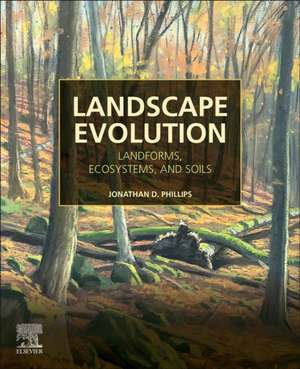Landscape Evolution: Landforms, Ecosystems, and Soils
Autor Jonathan D. Phillipsen Limba Engleză Paperback – 5 mai 2021
- Serves as a primary theoretical resource on landscape evolution, Earth surface system development, and environmental responses to climate and land use change
- Incorporates key ideas on geomorphic, soil, hydrologic, and ecosystem evolution and responses in a single book
- Includes case studies to provide real-world examples of evolving landscapes
Preț: 690.24 lei
Preț vechi: 901.96 lei
-23% Nou
Puncte Express: 1035
Preț estimativ în valută:
132.10€ • 136.46$ • 109.94£
132.10€ • 136.46$ • 109.94£
Carte tipărită la comandă
Livrare economică 19 martie-02 aprilie
Preluare comenzi: 021 569.72.76
Specificații
ISBN-13: 9780128217252
ISBN-10: 0128217251
Pagini: 356
Ilustrații: Approx. 100 illustrations
Dimensiuni: 191 x 235 x 24 mm
Greutate: 0.62 kg
Editura: ELSEVIER SCIENCE
ISBN-10: 0128217251
Pagini: 356
Ilustrații: Approx. 100 illustrations
Dimensiuni: 191 x 235 x 24 mm
Greutate: 0.62 kg
Editura: ELSEVIER SCIENCE
Public țintă
Academic and research scientists across the Earth sciences.Environmental restoration and rehabilitation professionals; natural resource and land management professionals; academia in geography, biology, and environmental science.
Cuprins
1. An integrated approach to landscape evolution2. Earth surface systems as supraorganisms3. Observing landscape evolution4. It depends on the scale: scale contingency in landscape evolution5. Historical contingency in landscape evolution6. Attractors and goal functions in landscape evolution7. Thresholds, tipping points, and instability8. Selection and landscape evolution9. The perfect landscape10. Landscape evolution and environmental change
Recenzii
"Starting with a deceptively simple sentence, “Landforms, topography, soils, and ecosystems affect, and are affected by, each other (p. 1), this book tackles some of the biggest questions about the world around us. In essence, it sets out a vision and methodology for an integrated, coevolutionary approach to the development of Earth surface systems. Jonathan Phillips has a very strong track record of research and writing on the interactions between geomorphological, pedological, and ecological processes, with a particular focus on coevolutionary dynamics. He is the only person who could have written this volume, in which he brings together many strands of his work to date, providing a provocative, detailed, and magisterial account of what we know and the challenges that face attempts to push back the frontiers of knowledge. The author is unafraid of delving into complexity and controversy, and expects a lot of his readers. As a result, this volume is not an entirely easy read, but it is well worth wrestling with. He manages to link big, brave conceptual ideas with formal mathematical approaches (such as abstracted systems theory) and apply these to detailed case studies. He covers a broad sweep of ideas and material from a diverse range of disciplines, and explains concepts in an engaging way. I learned a lot. Some of the contents will be familiar to those who have read some of his prolific output of scientific papers over the years, but the novelty lies in bringing it all together in a single place, and in attempting to tie it all together convincingly....
Who should read this volume? It is aimed at academic and research scientists across the Earth sciences, but students in those disciplines will also find much of interest here. Its strong points are its bold vision and persuasive arguments....
Overall, this is a stimulating and brave volume, which provides a thought-provoking summary of a major corpus of scientific scholarship." --Heather A. Viles, The Quarterly Review of Biology
Who should read this volume? It is aimed at academic and research scientists across the Earth sciences, but students in those disciplines will also find much of interest here. Its strong points are its bold vision and persuasive arguments....
Overall, this is a stimulating and brave volume, which provides a thought-provoking summary of a major corpus of scientific scholarship." --Heather A. Viles, The Quarterly Review of Biology
